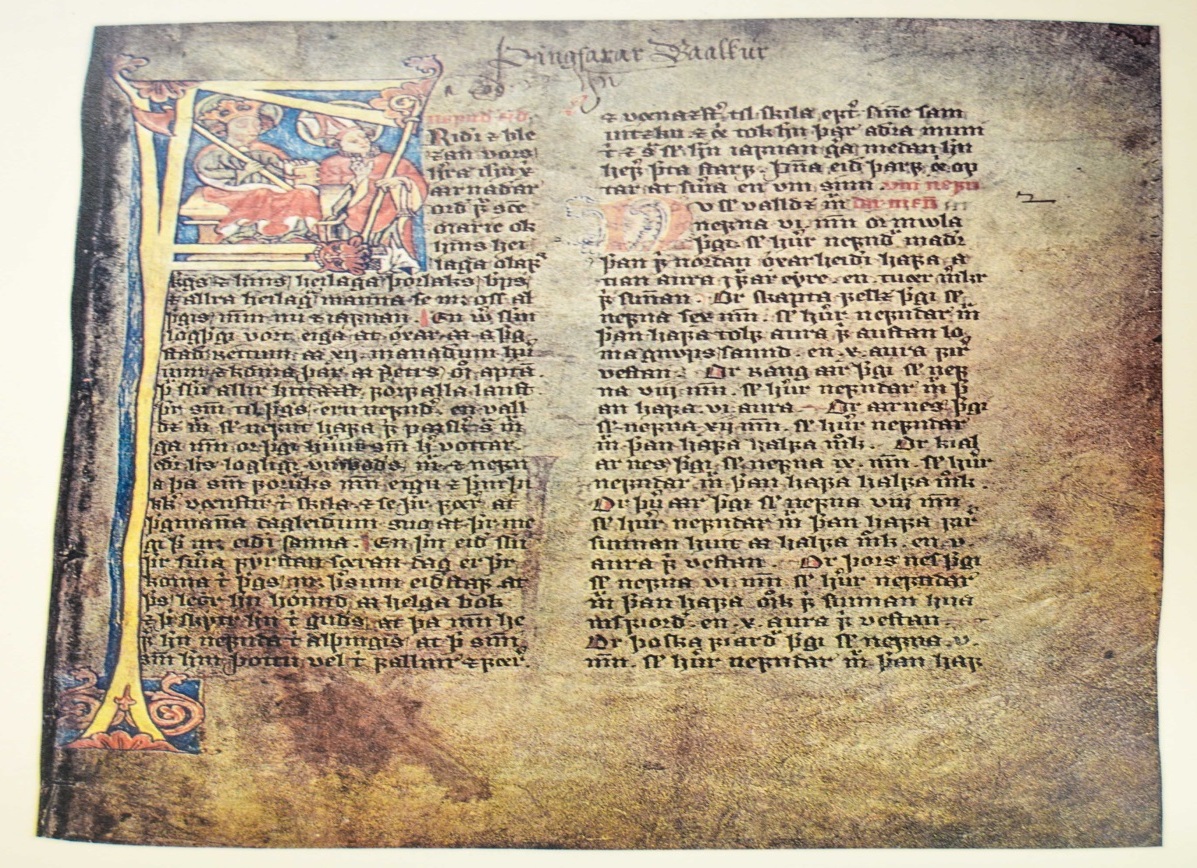|
Járnsíða
Járnsíða (, ''ironside'') was a law-code which Magnus VI of Norway had composed for Iceland, which came formally under Norwegian control during 1262–1264. ''Járnsíða'' was introduced over 1271–1273, superseding the previous law-code ''Grágás''. Amongst other things, ''Járnsíða'' formally put all legislative powers in the hands of the King, abolished the ''goðar'', and reformed the Alþingi. In 1281, ''Járnsíða'' was itself superseded by '' Jónsbók''. See also *Law of Iceland Law of Iceland during the Commonwealth (930—1262) was decided by the Althing. It has changed over the years but the legislative body is still called Althing. History Prior to 1262 the law-code was ''Grágás''. Following the '' Gamli sáttmá ... References *Haraldur Bernharðsson, Magnús Lyngdal Magnússon and Már Jónsson, Járnsíða og kristinréttur Árna Þorlákssonar (Reykjavík: Sögufélagið, 2005). Legal history of Iceland {{iceland-stub ... [...More Info...] [...Related Items...] OR: [Wikipedia] [Google] [Baidu] |
Law Of Iceland
Law of Iceland during the Commonwealth (930—1262) was decided by the Althing. It has changed over the years but the legislative body is still called Althing. History Prior to 1262 the law-code was ''Grágás''. Following the '' Gamli sáttmáli'', Magnus VI of Norway introduced the law-code '' Járnsíða'', which was itself superseded when existing laws were compiled in the Jónsbók by Jón Einarsson (in 1281). The Althing was suspended in 1799, and re-established in 1845 as an advisory body of the Danish king and from 1874 as a legislative body. The legislative body of the modern Republic of Iceland (since 1944) is again known as Althing. Uses of old laws Old laws are still quoted, the 13th century law of Grágás was used in a case in 2017 regarding an injury caused during a friendly fight. See also * Icelandic nationality law Icelandic nationality law is based upon the principles of jus sanguinis. In other words, descent from an Icelandic parent is the primary m ... [...More Info...] [...Related Items...] OR: [Wikipedia] [Google] [Baidu] |
Magnus VI Of Norway
Magnus Haakonsson ( non, Magnús Hákonarson, no, Magnus Håkonsson, label=Modern Norwegian; 1 (or 3) May 1238 – 9 May 1280) was King of Norway (as Magnus VI) from 1263 to 1280 (junior king from 1257). One of his greatest achievements was the modernisation and nationalisation of the Norwegian law-code, after which he is known as Magnus the Law-mender ( non, Magnús lagabœtir, links=no, no, Magnus Lagabøte, label=Modern Norwegian). He was the first Norwegian monarch known to have used an ordinal number, although originally counting himself as "IV". Early life He was the youngest son of King Håkon Håkonsson and his wife Margaret Skulesdatter. He was born in Tunsberg and was baptised in May 1238. He spent most of his upbringing in Bergen. In 1257 his older brother Håkon died, leaving Magnus the heir-apparent to the kingdom. His father gave him the title of king the same year. On 11 September 1261, he married Ingeborg, the daughter of King Eric IV of Denmark, after she was p ... [...More Info...] [...Related Items...] OR: [Wikipedia] [Google] [Baidu] |
Grágás
The Gray (Grey) Goose Laws ( is, Grágás {{IPA-is, ˈkrauːˌkauːs}) are a collection of laws from the Icelandic Commonwealth period. The term ''Grágás'' was originally used in a medieval source to refer to a collection of Norwegian laws and was probably mistakenly used to describe the existing collection of Icelandic law during the sixteenth century. The Grágás laws in Iceland were presumably in use until 1262–1264 when Iceland was taken over by the Norwegian crown. Origins of Icelandic law According to Ari Thorgilsson, the earliest Icelandic laws were modeled on those from the Norwegian west-coast law-province, Gulathing. These were introduced to Iceland by an immigrant from Norway named Úlfljótr, sometime during the 920's. Following several years of modification and revision, Úlfljótr's laws were approved by an initial assembly. Out of this meeting, the annual general assembly known as the Althing was established. Each following summer, Icelanders would conven ... [...More Info...] [...Related Items...] OR: [Wikipedia] [Google] [Baidu] |
Goði
Gothi or (plural , fem. ; Old Norse: ) was a position of political and social prominence in the Icelandic Commonwealth. The term originally had a religious significance, referring to a pagan leader responsible for a religious structure and communal feasts, but the title is primarily known as a secular political title from medieval Iceland. Etymology The word derives from , meaning "god".Byock, Jesse L. (1993). "Goði". Entry in ''Medieval Scandinavia, an Encyclopedia'' (Phillip Pulsiano, ed.), 230–231. Garland: NY and London, . It possibly appears in Ulfilas' Gothic language translation of the Bible as for "priest", although the corresponding form of this in Icelandic would have been an unattested . In Scandinavia, there is one surviving attestation in the Proto-Norse form from the Norwegian Nordhuglo runestone (Rundata N KJ65 U),The article ''gotiska'' in ''Nationalencyklopedin'' (1992) and in the later Old Norse form from three Danish runestones: DR 190 Helnæs, DR 192 ... [...More Info...] [...Related Items...] OR: [Wikipedia] [Google] [Baidu] |
Alþingi
The Alþingi (''general meeting'' in Icelandic, , anglicised as ' or ') is the supreme national parliament of Iceland. It is one of the oldest surviving parliaments in the world. The Althing was founded in 930 at ("thing fields" or "assembly fields"), situated approximately east of what later became the country's capital, Reykjavík. Even after Iceland's union with Norway in 1262, the Althing still held its sessions at until 1800, when it was discontinued. It was restored in 1844 by royal decree and moved to Reykjavík. The restored unicameral legislature first came together in 1845 and after 1874 operated in two chambers with an additional third chamber taking on a greater role as the decades passed until 1991 when Althing became once again unicameral. The present parliament building, the , was built in 1881, made of hewn Icelandic stone. The unicameral parliament has 63 members, and is elected every four years based on party-list proportional representation. The current ... [...More Info...] [...Related Items...] OR: [Wikipedia] [Google] [Baidu] |



